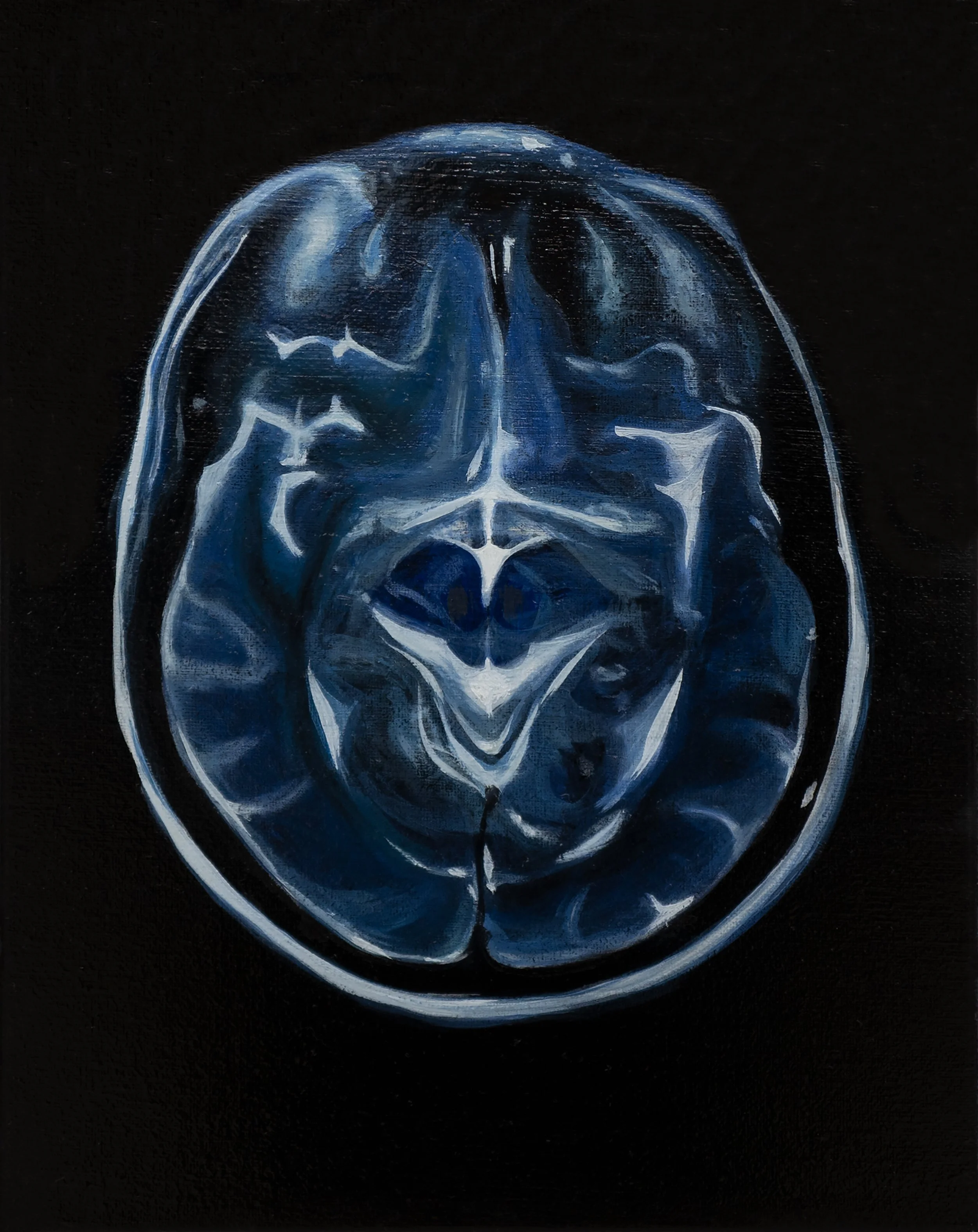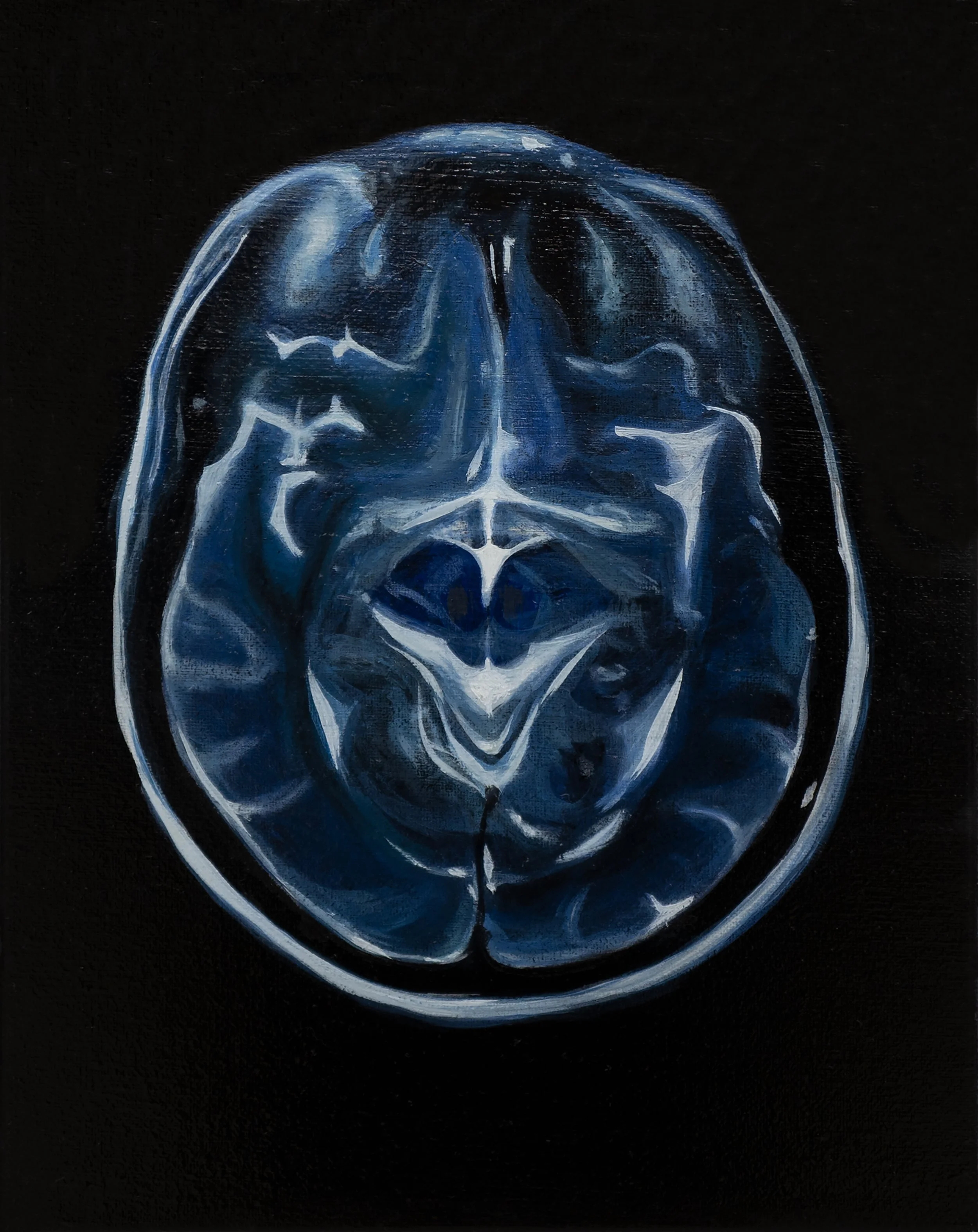MRI, 2021
MRI, 2021
Oil on linen
36 x 28 cm (14 x 11 in)
MRI (2021) presents a cross-sectional image of the brain, captured through magnetic resonance imaging (MRI) technology, revealing the complex and powerful functions of the human brain. This internal view reflects one of Tan Mu’s ongoing themes: exploring the complex and interconnected structures of biological and technological systems, and the similarities in the flow of information within them. MRI technology enables scientists to observe the brain in action—learning, seeing, remembering, hearing, perceiving, understanding, and generating language. Cognitive psychologists study how individuals acquire, perceive, process, and store information, as well as how cognition interacts with emotion. However, the brain’s functions are not infallible. Using tools like MRI, researchers delve into the brain’s responses to specific stimuli, gaining a deeper understanding of how structural differences influence a person’s health, personality, and cognitive abilities. Through this lens, MRI not only captures the brain’s structure but also prompts reflection on the immense potential and vulnerability of human cognition.
Q: What inspired you to create MRI?
Tan Mu: In 2019, during a deep freediving session, I experienced an incident of cerebral hypoxia. The lack of oxygen may have temporarily affected the function of my hippocampus, impairing memory storage and retrieval. After undergoing medical tests, I became deeply intrigued by the structure of the brain and the nervous system, particularly its role as a reservoir for memory. The memory gaps caused by the trauma and the freediving accident prompted me to explore the brain's intricate structure. This experience not only heightened my appreciation for the brain's complex connections but also made me acutely aware of its fragility. Coincidentally, I read Three Pound Universe, which compares the human brain to a three-pound universe—a microcosm of the cosmos, with the universe itself resembling a vast brain. This parallel between the internal and the cosmic sparked a sense of awe, reminding me how art can bridge the intimate and the infinite.
Q: Can you elaborate on the connection you mentioned between the structure of the brain and the universe?
Tan Mu: I was inspired by the Three Pound Universe and the concept of the "universe as a concept"—a structural framework that connects different dimensions of existence, from the atomic scale of particles to the brain scale of human cognition and the galaxy scale of cosmic systems. In my work, I depict structures such as atoms, cells, embryos, MRI scans, and logic circuits, extending to cross-sections of undersea cables and the vast observable universe. These visual elements map a multidimensional structure that bridges the micro and macro, offering a lens to explore connections across scales.
From this perspective, the brain, with its intricate neural pathways, functions as a biological data center, storing and processing personal memories. This analogy reveals the interconnectedness between individual cognition and collective, universal systems. It also provides a visual framework for my artistic exploration, delving into the hidden architectures that shape both human understanding and the world itself. By revealing the complex interplay between these dimensions, my work aims to uncover the profound relationships between cognition and the expansive structures of the universe.
Q: You mentioned that you view the brain as an internal data center for memory. Could you elaborate on that idea?
Tan Mu: I have explored the similarities between the brain and technology, particularly the comparison between neural synapses and logic circuits, the analogy between the brain's neural network and the global undersea cable network, and the comparison between the brain, which serves as an internal memory storage, and external data centers that store information. In my view, the brain stores personal memories through its neural pathways, undersea cables transmit collective human knowledge and emotions through nodes and pipelines, and collective human memory is ultimately stored in data centers. These systems are interconnected through points, lines, and surfaces, creating a fabric of memory that explores the intersection between biological and technological systems. It reveals the complex patterns in the evolving structure of memory, offering a visual narrative that merges historical elements and personal experiences with the digital age, encouraging the audience to reflect on the subtle dynamics between these realms.
Q: MRI technology allows scientists to observe brain activity and enables artists to depict things beyond the visible range. How do you view this technological extension?
Tan Mu: I view technology as both an extension of the body and an externalization of memory. Both Yuk Hui and Marshall McLuhan have explored this concept, emphasizing how technology extends our senses and bodies. Devices like smartphones, microscopes, MRI scanners, and telescopes expand our vision, enabling us to capture information across distances, observe microscopic and internal bodily structures, and view images from outer space. For artists, these technologies provide access to visual information beyond the surface of things. Much of my work documents the images captured by these extended organs, celebrating the breakthroughs that technology has made possible.


